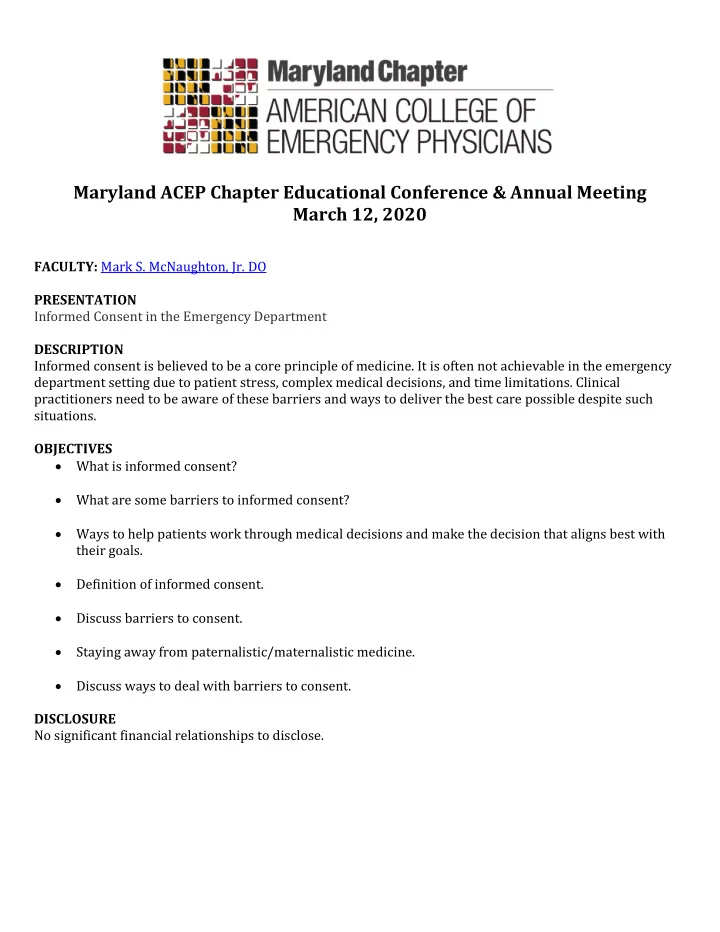

Maryland ACEP Chapter Educational Conference & Annual Meeting March 12, 2020 FACULTY: Mark S. McNaughton, Jr. DO PRESENTATION Informed Consent in the Emergency Department DESCRIPTION Informed consent is believed to be a core principle of medicine. It is often not achievable in the emergency department setting due to patient stress, complex medical decisions, and time limitations. Clinical practitioners need to be aware of these barriers and ways to deliver the best care possible despite such situations. OBJECTIVES • What is informed consent? • What are some barriers to informed consent? • Ways to help patients work through medical decisions and make the decision that aligns best with their goals. • Definition of informed consent. • Discuss barriers to consent. • Staying away from paternalistic/maternalistic medicine. • Discuss ways to deal with barriers to consent. DISCLOSURE No significant financial relationships to disclose.
Informed Consent in ED Mark McNaughton
NO
NO Vodka
Informed consent In seeking a patient’s informed consent (or the consent of the patient’s surrogate if the patient lacks decision-making capacity or declines to participate in making decisions), physicians should: (a) Assess the patient’s ability to understand relevant medical information and the implications of treatment alternatives and to make an independent, voluntary decision. (b) Present relevant information accurately and sensitively, in keeping with the patient’s preferences for receiving medical information. The physician should include information about: The diagnosis (when known) The nature and purpose of recommended interventions The burdens, risks, and expected benefits of all options, including forgoing treatment (c) Document the informed consent conversation and the patient’s (or surrogate’s) decision in the medical record in some manner. When the patient/surrogate has provided specific written consent, the consent form should be included in the record.
Informed consent In seeking a patient’s informed consent (or the consent of the patient’s surrogate if the patient lacks decision-making capacity or declines to participate in making decisions), physicians should: (a) Assess the patient’s ability to understand relevant medical information and the implications of treatment alternatives and to make an independent, voluntary decision. (b) Present relevant information accurately and sensitively, in keeping with the patient’s preferences for receiving medical information. The physician should include information about: The diagnosis (when known) The nature and purpose of recommended interventions The burdens, risks, and expected benefits of all options, including forgoing treatment (c) Document the informed consent conversation and the patient’s (or surrogate’s) decision in the medical record in some manner. When the patient/surrogate has provided specific written consent, the consent form should be included in the record.
(a) Assess the patient’s ability to understand relevant medical information and the implications of treatment alternatives and to make an independent, voluntary decision.
(a) Assess the patient’s ability to understand relevant medical information and the implications of treatment alternatives and to make an independent, voluntary decision.
Informed consent
Informed consent In seeking a patient’s informed consent (or the consent of the patient’s surrogate if the patient lacks decision-making capacity or declines to participate in making decisions), physicians should: (a) Assess the patient’s ability to understand relevant medical information and the implications of treatment alternatives and to make an independent, voluntary decision. (b) Present relevant information accurately and sensitively, in keeping with the patient’s (b) Present relevant information accurately and sensitively, in keeping with the patient’s preferenc nces for r receiving m medical inf nform rmation. n. T The physician s n shoul uld i d include ude inf nform rmation n about: The diagnosis (when known) The diagnosis (when known) The nature and purpose of recommended interventions The nature and purpose of recommended interventions The burdens, risks, and expected benefits of all options, including forgoing treatment The burdens, risks, and expected benefits of all options, including forgoing treatment
Full disclosure for procedure involves 1. condition being treated 2. Nature and character of proposed treatment/procedure 3. Anticipated results 4. recognized possible alternative forms 5. serious risks/complications 6. anticipated benefits 7. alternative forms of treatment 8. risks of non treatment 9. personal or economic interests that influence judgment 10. all diagnostic tests that may rule out a possible condition 11. information reasonable person in the patients position may find important - first time?
First do no harm
Paternalism/maternalism Why its bad. What we need to avoid
Overwhelmed from emotional standpoint
Informational overload
Ways to phrase things in talking to patients Will fill in a couple of standard communication skills here.
Recommend
More recommend